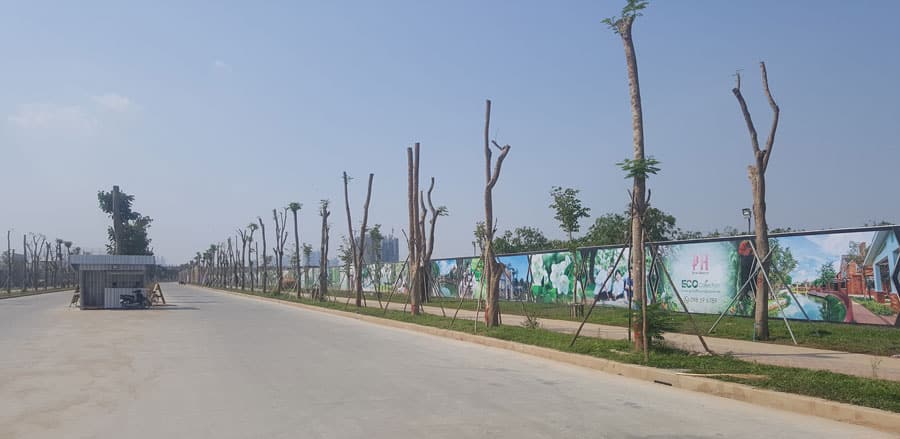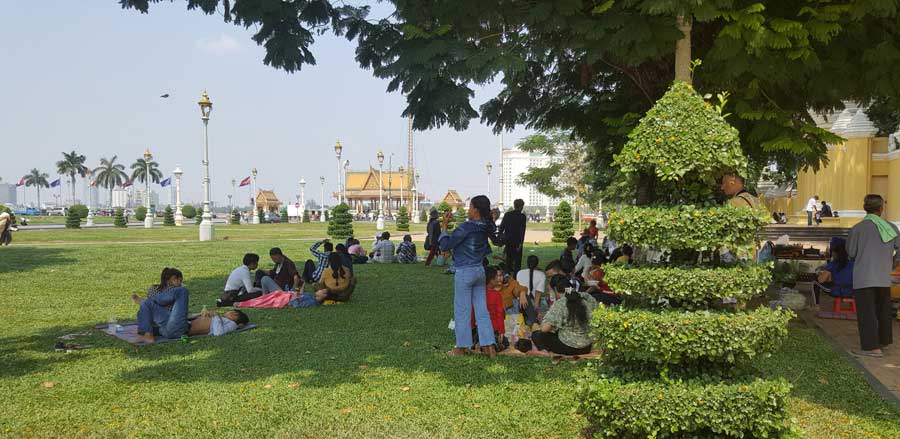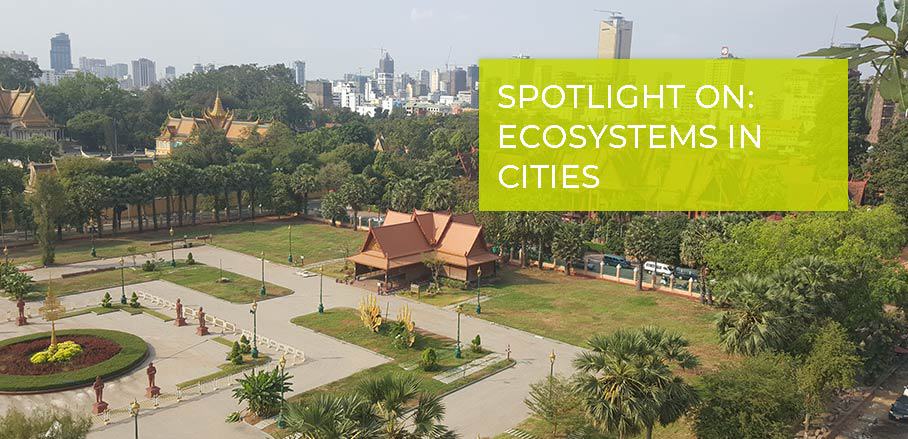Phnom Penh: Urban Development Towards a Green City
Research evidences that intact ecosystems within cities considerably improve the quality of citizens’ lives. The Cambodian-German project Build4People aims to include urban ecosystems into the long-term urban planning strategies of Cambodian cities. Jan-Peter Mund, Ravi Jayaweera, Hor Sanara, and Michael Waibel present the ambitious project.
Cambodia’s rapid economic growth over the past decade accelerated urban growth in and around the capital Phnom Penh. According to the Cambodia Socio-Economic Survey, the urban population has increased from 1.36 million to 1.95 million between 2010 and 2017 alone. Phnom Penh’s population is expected to double by 2030.
The growing number of citizens drives the continuing replacement of the natural environment by urban built-up quarters and infrastructure, leading to a massive transformation: from a city dominated by gravel roads, a low-rise urban morphology, and historical villas surrounded by private gardens in the early 1990s to a modern metropolis dominated by a set of skyscrapers and encircled by satellite cities.
Natural environment and open spaces within city boundaries have been decreasing continuously. The most prominent example is the filling of the Boeung Kak Lake, a former lake that today forms the base for a new Central Business District close to the historical city centre.
Urban Green Contributes Multifaceted Features to the Quality of Life
Urban green spaces belong to global ecosystems which supply ecosystem services, such as biodiversity and climate regulations. They offer multifaceted features of quality of life for local residents such as options for local recreation, cleaner air, lower temperature, and a more pleasant scenery. Recently, scholars have drawn parallels between urban green spaces (UGS) and general human well-being and people’s health – physically, socially, and mentally. Despite these benefits relatively little attention has been paid to the issue of urban green in Cambodia and Phnom Penh’s new Master Plan for 2035.
A research project funded by the German Ministry of Education and Research (BMBF) now investigates the extent of urban green and the potential benefits for citizens, urban climate, and eco-systems. The project “Sustainable Buildings for People – Enhancing Urban Quality of Life in Cambodia”, implemented in late 2017, understands the concept of urban quality of life as “the link between the level of the building and the spatial level of the city regarding issues of urban green and of urban climate”.

New planted roadside or alley trees in the Penh Houth new borey development (“gated community”) ECO-melody town in SE Phnom Penh © Jan-Peter Mund
Thereby, urban quality of life is regarded as the connecting scientific-conceptional, analytical, and superior normative bracket that underpins all research activities of the Build4People project. Environmental psychologists will therefore particularly focus on the subjective dimension of urban quality and investigate the residents’ satisfaction levels with their city, for example with regard to their access to urban green.
Hence, both extent and quality of urban green space define parts of the overall function of the quality of urban life. Focussing on the Urban Green aspect of the research project, the University for Sustainable Development Eberswalde (HNEE) conducts research activities with a focus on remote sensing techniques.
Spatial environmental data analysis using GIS and remote sensing methods allows segmenting quantifiable spatial information about green spatial structures such as the distribution and the spatial density of UGS in Phnom Penh.
Sustainable Neighbourhoods are Key to Enhance the Quality of Urban Life
The research team considers sustainable neighbourhoods, including UGS, as key elements for the enhancement of the urban quality of life in Phnom Penh. Furthermore, such neighbourhoods are crucial for climate protection, climate adaptation, and resilience. The project brings together heterogeneous researchers from German and Cambodian universities as well as local implementation partners such as the Phnom Penh Capital Administration to work on plans and criteria for sustainable developments.
People-centred urban planning is considered as a crosscutting task that requires interaction and more than legal regulations. The research results of the project can feed into more sustainable urban planning and governance practices of the Phnom Penh municipality.
UGS, including parks and gardens, are subsistent components of urban environment systems. Spatial research shows inner city parks and other artificial green spaces in Phnom Penh – like Temple (Wat) compounds or cultural urban green space around the Royal Palace – with high vegetation consisting of cultivated trees, bushes, and urban gardens.
A comparison of satellite images indicates that those traditional UGS are not under significant threat from urbanisation. Less densely vegetated urban fallow land however, especially in areas of intense city sprawl, is facing severe land use competition and is thus threatened to be converted into built-up areas or sealed surfaces in the near future. To improve urban planning, B4P researchers also investigate the needs, attitude, and expectations of Phnom Penh citizens towards urban green. Green spaces are used for relaxation as many interviewees stated: “I can relax here or come here to exercise early morning or after work” are common answers.
The interviews also highlight the social function of green space in Phnom Penh allowing interaction among people: “I can enjoy and see a lot of people and many different people.” or “I bring my kids here to ride their bicycle”. In the interviews, many Phnom Penh citizens stated their appreciation of green spaces but have also expectations to improve parks and gardens. Citizens would like to see more lights so the parks can be used in the evening. Benches, gym equipment, and high trees would improve the recreational value according to the interviewees. A perfect green space, an interviewee said, is a park where “the trees are tall and there is plenty of green space and clear walkways and bicycle lanes for other people to exercise.”

Citizen meeting and resting in the shadow on public green space in front of the Royal Palace in Phnom Penh. © Jan-Peter Mund
Urban Green is on the Phnom Penh Municipality Agenda
The municipal “Green City Strategic Plan for Phnom Penh” from 2018 provides a roadmap for Cambodian policymakers and local administrators for implementation of economic development, poverty alleviation, and social inclusion. Thereby, the “Green City Concept” serves as an umbrella term that covers various notions of sustainable urbanism addressing adaptation to climate change, climate resilient cities, and ecological city concepts pursuing, among others, resource efficiency, low carbon impact, and improvement of the environmental living quality for the next decades.
The “Green City Concept” embraces comprehensive spatial planning for the maintenance and creation of new urban green spaces and an urban green infrastructure. The multi-layered roadmap poses a number of challenges to urban planners, including sustainability, environmental impact, and participatory planning approaches. “Urban Green” is only one of the pivotal planning challenges.
Already in 2018, the Royal Government of Cambodia identified the high importance of investing in urban infrastructure – particularly in the improvement of urban planning procedures and UGS. The predicted urbanisation of Phnom Penh increases the need for the monitoring of the spread of impervious surfaces and the simultaneously occurring but inverted decline of urban vegetation.
The Build4People project can support capacities in this regard. Besides its usage for the general maintenance of urban green and the wastewater management, the spatial information it collects is one substantial data layer in early warning systems concerning natural hazards, their mitigation (flood control), and climate impact research. Such up-to-date spatial information is essential for comprehensive and sustainable urban planning that can support the realisation of the “Green City Strategic Plan for Phnom Penh”.
